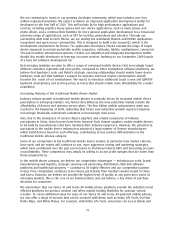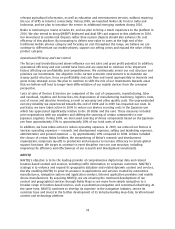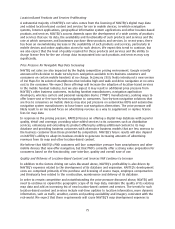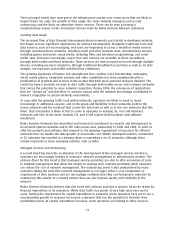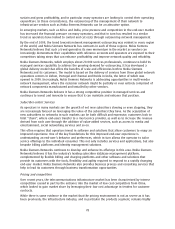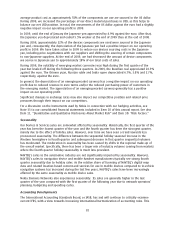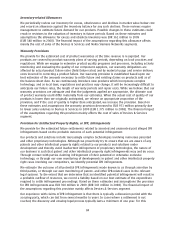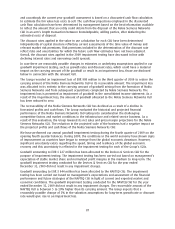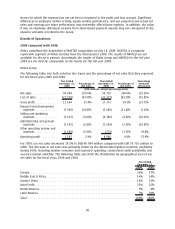Nokia 2009 Annual Report Download - page 83
Download and view the complete annual report
Please find page 83 of the 2009 Nokia annual report below. You can navigate through the pages in the report by either clicking on the pages listed below, or by using the keyword search tool below to find specific information within the annual report.average product cost as approximately 55% of the components we use are sourced in the US dollar.
During 2009, we increased the percentage of our direct material purchases in USD, as this helps to
balance our net USD position. In total, the movements of the US dollar against the euro had a slightly
negative impact on our operating profit in 2009.
In 2009, until the end of January the Japanese yen appreciated by 4.9% against the euro. After that,
the Japanese yen depreciated and ended 5.5% weaker at the end of 2009 than at the end of 2008.
During 2009, approximately 22% of the devices components we used were sourced in the Japanese
yen and, consequently, the depreciation of the Japanese yen had a positive impact on our operating
profit in 2009. We have taken action in 2009 to reduce our devices sourcing costs in the Japanese
yen, including price negotiations with our suppliers and shifting the sourcing of certain components
to nonJapanese suppliers. At the end of 2009, we had decreased the amount of device components
we source in Japanese yen to approximately 18% of our total costs of sales.
During 2009, the volatility of emerging market currencies was high during the first quarter of the
year but leveled off during the following three quarters. In 2009, the Brazilian real appreciated 26.5%
against the euro. The Chinese yuan, Russian ruble and India rupee depreciated 6.7%, 3.8% and 2.7%,
respectively, against the euro.
In general, the depreciation of an emerging market currency has a negative impact on our operating
profit due to reduced revenue in euro terms and/or the reduced purchasing power of customers in
the emerging market. The appreciation of an emerging market currency generally has a positive
impact on our operating profit.
Significant changes in exchange rates may also impact our competitive position and related price
pressures through their impact on our competitors.
For a discussion on the instruments used by Nokia in connection with our hedging activities, see
Note 33 to our consolidated financial statements included in Item 18 of this annual report. See also
Item 11. “Quantitative and Qualitative Disclosures About Market Risk” and Item 3D. “Risk Factors.”
Seasonality
Our Devices & Services sales are somewhat affected by seasonality. Historically, the first quarter of the
year has been the lowest quarter of the year and the fourth quarter has been the strongest quarter,
mainly due to the effect of holiday sales. However, over time we have seen a trend towards less
pronounced seasonality. The difference between the sequential holiday seasonal increase in the
Western hemisphere in fourth quarter and subsequent decrease in first quarter sequential volumes
has moderated. The moderation in seasonality has been caused by shifts in the regional makeup of
the overall market. Specifically, there has been a larger mix of industry volumes coming from markets
where the fourth quarter holiday seasonality is much less prevalent.
NAVTEQ’s sales to the automotive industry are not significantly impacted by seasonality. However,
NAVTEQ’s sales to navigation device and mobile handset manufacturers typically see strong fourth
quarter seasonality due to holiday sales. As the relative share of licensing of NAVTEQ’s digital map
data and related locationbased content and services for use in mobile devices compared to invehicle
navigation systems has increased during the last few years, NAVTEQ’s sales have been increasingly
affected by the same seasonality as mobile device sales.
Nokia Siemens Networks also experiences seasonality. Its sales are generally higher in the last
quarter of the year compared with the first quarter of the following year due to network operators’
planning, budgeting and spending cycles.
Accounting Developments
The International Accounting Standards Board, or IASB, has and will continue to critically examine
current IFRS, with a view towards increasing international harmonization of accounting rules. This
81




